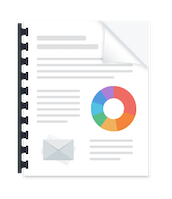6 Ways Nonprofits Can Improve Their Email Creation Process [Infographic]
Nonprofits perform life-changing work, and email marketing is a key way for them to rally people to their cause, raise funds, and direct action. However, nonprofits’ operations are notoriously lean. That is definitely the case with their email marketing operations, according to the responses of more than 240 nonprofits who took Litmus’ 2018 State of Email Survey.
In this infographic, we highlight some of the unique challenges that the email teams at nonprofit organizations face. In collaboration with nonprofit research consultancy NextAfter, who promoted our survey to their community members, we also offer advice on six ways that nonprofits can improve their email programs.

Get More Insights from Litmus’ Research

Benchmark your email program against the practices of thousands of marketers worldwide, gain valuable insights, and explore trends in the blog posts, webinars, and research reports based on Litmus’ State of Email Survey.
INFOGRAPHIC TRANSCRIPT
6 Ways Nonprofits Can Improve Their Email Creation Process
Nonprofits rely heavily on email marketing, but their email programs often suffer from underinvestment and therefore under-performance.
79% of nonprofits say email marketing is important to the overall success of their organization.
However…
58% of marketers at nonprofits say their email program is under-resourced.
The email teams at nonprofits are small, composed of only 4.2 employees vs. 7.7 employees across all industries.
Nonprofits have an average of 2.3 full-time employees and 1.9 full-time employees.
Brands across all industries have an average of 5.6 full-time employees and 2.1 full-time employees.
And smaller budgets have led to nonprofits generally having less sophisticated email creation and quality assurance processes and toolsets.
Nonprofits are 51% more likely to use a WYSIWYG editor to build emails
- 28% of nonprofits use a WYSIWYG editor to build emails
- 19% of brands across all industries use a WYSIWYG editor to build emails
Nonprofits are 81% more likely to use the code editor provided by their email service provider
- 53% of nonprofits use the code editor provided by their ESP
- 29% of brands across all industries use the code editor provided by their ESP
Nonprofits are 16% less likely to use responsive design for their broadcast and segmented emails (and are even less likely to use it for their automated and transactional emails)
- 57% of nonprofits use responsive design for their broadcast and segmented emails
- 68% of brands across all industries use responsive design for their broadcast and segmented emails
Nonprofits are 47% less likely to use partials to easily update content across many emails
- 12% of nonprofits use partials
- 22% of brands across all industries use partials
Nonprofits are 43% less likely to use preprocessing to write email code
- 8% of nonprofits use preprocessing
- 14% of brands across all industries use preprocessing
Nonprofits are 59% less likely to use postprocessors to ensure code compatibility across email clients
- 4% of nonprofits use postprocessors
- 10% of brands across all industries use postprocessors
Nonprofits are 23% less likely to inline CSS to improve email rendering
- 66% nonprofits inline CSS
- 86% all industries inline CSS
Nonprofits are 41% less likely to use an extensive pre-send checklist to catch errors
- 13% of nonprofits use an extensive pre-send checklist
- 23% of brands across all industries use an extensive pre-send checklist
Nonprofits are 343% more likely to never test the rendering and functionality of their emails or templates
- 16% of nonprofits never test the rendering and functionality of their emails or templates
- 4% of brands across all industries never test the rendering and functionality of their emails or templates
Nonprofits are 11% less likely to run spam filter tests before sending an email to improve deliverability
- 48% of nonprofits run spam filter tests
- 54% of brands across all industries run spam filter tests
As a result, nonprofits have significantly less email production capacity, and send fewer broadcast and automated marketing emails than other organizations.
Nonprofits have 33% fewer emails in production at any time on average
- 6.4 emails in production at any time on average among nonprofits
- 9.6 emails in production at any time on average among brands across all industries
Nonprofits send 22% fewer emails to their subscribers
- 6.2 emails/month sent to subscribers among nonprofits
- 7.9 emails/month sent to subscribers among brands across all industries
50% fewer nonprofits generate at least a quarter of their email marketing revenue from automated emails
- 19% of nonprofits generate at least a quarter of their email marketing revenue from automated emails
- 37% of brands across all industries generate at least a quarter of their email marketing revenue from automated emails
Because of all of those challenges, only 44% of nonprofit email marketers say their email program is successful.
Here are 6 tips to help you improve your email process and make your email program more successful:
- Get creative when asking for more resources. Lobby for reallocating resources from lower-ROI channels to email. See if an existing employee can join the email team part-time, building up their skills. Working with freelancers can also be a great first step toward proving the positive impact more resources can have on your email program.
- Adopt email production tools that let you automate time-consuming tasks. Use reusable code snippets and partials, Emmet, automatic CSS inliners, or other tools that cut manual work, reduce production times, and decrease the chance of errors so you can get great emails out the door faster, even if your team is small.
- Adopt responsive email templates. Half of all emails are opened on mobile devices. Serve those subscribers better by downloading responsive email templates that make it easy to code mobile-friendly emails.
- Make quality control a priority. You can’t make a case for your cause if your emails are broken or don’t look great to your subscribers. Adopt a pre-send checklist and test the rendering and functionality of your emails across inbox providers—both of which are proven techniques for making a great impression in the inbox and increasing program success.
- Send more personal, relevant emails. Sending more segmented emails, re-targeting emails to non-openers, and emails during peak donation or activity seasons are all ways to increase email frequency while minimizing email fatigue. Giving all of those emails a more personal look and feel also boosts performance. Relatedly…
- Utilize the power of automated emails. Create a signup welcome series, “Thank You” emails triggered by donations, donation request emails triggered by petition signings, support anniversary emails, and more. With a longer shelf-life than most one-off campaigns, these types of emails are one of the most efficient ways you can use your limited resources.
Email is often a nonprofit’s most productive marketing channel by far, but they shouldn’t be satisfied. Even better returns are possible with greater investments in processes, staffing, and resources.
Source: Litmus’ 2018 State of Email Survey of nearly 3,000 marketing professionals worldwide, including 241 nonprofits, between Dec. 19, 2017 and Jan. 31, 2018. Litmus is grateful to NextAfter for promoting the survey to its community of nonprofits. For more insights from the State of Email Survey, visit litmus.com/stateofemail.
 | Litmus <3 NonprofitsTo help nonprofits get the most from their email marketing, Litmus is proud to offer a discount to eligible organizations. Email billing@litmus.com for more details. |

Chad S. White
Chad S. White was the Research Director at Litmus
